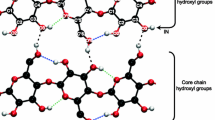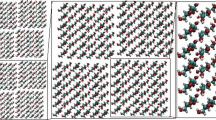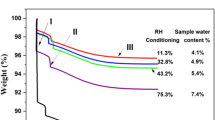Abstract
This paper aims at a better understanding of the interaction between cellulose and moisture. In particular, the role of different hydrogen bonds in moisture uptake is investigated. Dynamic Fourier transform infrared spectroscopy (FT-IR) has been used in combination with deuterium exchange, which permits the labelling of cellulose domains with different accessibilities.
The static spectra indicate a marked exchange of deuterium for the O2–H⋯O6 bonds, but only a limited exchange for the O3–H⋯O5 bonds. In the dynamic FT-IR spectra, deuteration gives rise to the growth of a broad band at wavenumbers around 2500 cm−1. The rather unstructured appearance of the band suggests that deuteration is occurring only on the surface of the cellulose crystallites, i.e. in more or less non-load-carrying parts. This is corroborated by the lack of split peaks related to OD bonds in this band. In agreement with these observations, the split peak related to O3–H⋯O5 bonds and assigned to the load carrying cellulose structure increases during both H2O and D2O moisture conditioning, indicating a shift of the load transfer towards the backbone of the cellulose structure.
Similar content being viewed by others
References
Åkerholm M. 2003. Ultrastructural aspects of pulp fibers as studied by dynamic FT-IR spectroscopy. Ph.D. Thesis, Royal Institute of Technology (KTH), Stockholm, Sweden
Åkerholm M. and Salmén L. 2001. Interactions between wood polymers studied by dynamic FT-IR spectroscopy. Polymer 42: 963–969
Atalla R.H. 1999. Celluloses. Carbohydrates and their derivatives including tannins, cellulose, and related lignin. In: Pinto B.M. (ed.), Carbohydrates and Their Derivatives Including Tannins, Cellulose, and Related Lignins, Vol. 3. Elsevier, Amsterdam, pp. 529–598
Bellamy L.J. and Rogasch P.E. 1960. Proton transfer in hydrogen bonded systems. Proc. Roy. Soc. Lond. A257: 98–108
Fengel D. and Ludwig M. 1991. Möglichkeiten und Grenzen der FTIR-Spektroskopie bei der Charakterisierung von Cellulose [Possibilities and limits for use of FTIR-spectroscopy for the characterization of cellulose]. Das Papier 45(2): 45–51 (in German)
Fengel D. and Wegener G. 1989. Wood. Chemistry, Ultrastructure, Reactions. Verlag Walter de Gruyter, Berlin, New York
Frilette V.J., Hanle J. and Mark H. 1948. Rate of exchange of cellulose with heavy water. J. Am. Chem. Soc. 70: 1107–1113
Hinterstoisser B. and Salmén L. 1999. Two-dimensional step-scan FTIR: a tool to unravel the OH-valency-range of the spectrum of Cellulose I. Cellulose 6: 251–263
Hinterstoisser B. and Salmén L. 2000. Application of dynamic 2D FTIR to cellulose. Vibration. Spectrosc. 22: 111–118
Hinterstoisser B., Åkerholm M. and Salmén L. 2001. Effect of fiber orientation in dynamic FTIR study on native cellulose. Carbohydr. Res. 334: 27–37
Hishikawa Y., Togawa E., Kataoka Y. and Kondo T. 1999. Characterization of amorphous domains in cellulosic materials using a FTIR deuteration monitoring analysis. Polymer 40: 7117–7124
Jeffries J. 1963. An infra-red study of the deuteration of cellulose and cellulose derivatives. Polymer 4: 375–389
Jeffries J. 1964. The amorphous fraction of cellulose and its relation to moisture sorption. J. Polym. Sci. 8: 1213–1220
Jarvis M.C. and McCann M.C. 2000. Macromolecular biophysics of the plant cell wall: concepts and methodology. Plant Physiol. Biochem. 38(1/2): 1–13
Kondo T. 1997. The assignment of IR absorption bands due to free hydroxyl groups in cellulose. Cellulose 4: 281–292
Liang C.Y. and Marchessault R.H. 1959a. Infrared spectra of crystalline polysaccharides. I. Hydrogen bonds in native celluloses. J. Polym. Sci. 37: 385–395
Liang C.Y. and Marchessault R.H. 1959b. Infrared spectra of crystalline polysaccharides. II. Native cellulose in region from 640 to 1700 cm−1. J. Polym. Sci. 39: 269–278
Mann J. and Marrinan H.J. 1956. The reaction between cellulose and heavy water (Parts I–III). Trans. Faraday Soc. 52: 481–497
Marrinan H.J. and Mann J. 1954. A study by infra-red spectroscopy of hydrogen bonding in cellulose. J. Appl. Chem. 4: 204–211
Nishiyama A., Isogai T., Okano M., Müller M. and Chanzy H. 1999. Intracrystalline deuteration of native cellulose. Macromolecules 32: 2078–2081
Nishiyama Y., Langan P. and Chanzy H. 2002. Crystal structure and hydrogen-bonding system in cellulose Iβ from synchrotron x-ray and neutron fiber diffraction. J. Am. Chem. Soc. 124: 9074–9082
Olsson A.-M. and Salmén L. 2004. The association of water to cellulose and hemicellulose in paper examined by FTIR spectroscopy. Carbohydr. Res. 3394: 813–818
O’Sullivan A.C. 1997. Cellulose: the structure slowly unravels. Cellulose 4: 173–207
Pennings A.J., Prins W., Hale R.D. and Ranby B.G. 1961. Inter- and intramolecular order in regenerated cellulose. J. Appl. Polym. Sci. 5(18): 676–684
Pérez S. and Mazeau K. 2005. Conformations, structures, and morphologies of celluloses. In: Dumitrui S. (ed.), Polysaccharides: Structural Diversity and Functional Versatility, 2nd ed. Marcel Dekker Inc., New York, pp. 41–68
Plummer C.J.G., Pittet V. and Navi P. 2001. The mechano-sorptive effect in wood: molecular dynamics simulations. In: Proceedings of the 1st Conference of the European Society of Wood Mechanics 2001, pp. 103–111
Rowland S.O. and Roberts E.J. 1972. The nature of accessible surfaces in the microstructure of native cellulose. J. Polym. Sci. Part A 10: 2447–2461
Settle F.A. 1997. Handbook of Instrumental Techniques for Analytical Chemistry. Prentice Hall, Upper Saddle River, NJ
Siesler H., Krässig H., Grass F., Kratzl K. and Derkosch J. 1975. Strukturuntersuchungen an Cellulosefasern verschiedenen Verstreckungsgrades mittels IR-Reflexionsspektros- kopie und Deuteriumaustausch [Structural investigation of cellulosic fibers with different degrees of drawing by means of infrared spectroscopy and deuterium exchange]. Die Angewandte Markomolekulare Chemie 42: 139–165 (in German)
Tashiro K. and Kobayashi M. 1991. Theoretical evaluation of three-dimensional elastic constants of native and regenerated cellulose: role of hydrogen bonds. Polymer 32(8): 1516–1526
Tsuchikawa S. and Siesler H.W. 2003a. Near-infrared spectroscopic monitoring of the diffusion process of deuterium-labeled molecules in wood. Part I. Softwood. Appl. Spectrosc. 57(6): 667–674
Tsuchikawa S. and Siesler H.W. 2003b. Near-infrared spectroscopic monitoring of the diffusion process of deuterium-labeled molecules in wood. Part II. Hardwood. Appl. Spectrosc. 57(6): 675–681
Acknowledgements
The FT-IR measurements were performed during a “Short Term Scientific Mission” of the first author to STFI-Packforsk, Stockholm, Sweden. The financial support of the European Science Foundation in the framework of COST action E35 is gratefully acknowledged. The authors would also like to thank Margaretha Åkerholm for valuable assistance with the FTIR-measurements.
Author information
Authors and Affiliations
Corresponding author
Rights and permissions
About this article
Cite this article
Hofstetter, K., Hinterstoisser, B. & Salmén, L. Moisture uptake in native cellulose – the roles of different hydrogen bonds: a dynamic FT-IR study using Deuterium exchange. Cellulose 13, 131–145 (2006). https://doi.org/10.1007/s10570-006-9055-2
Received:
Accepted:
Published:
Issue Date:
DOI: https://doi.org/10.1007/s10570-006-9055-2




